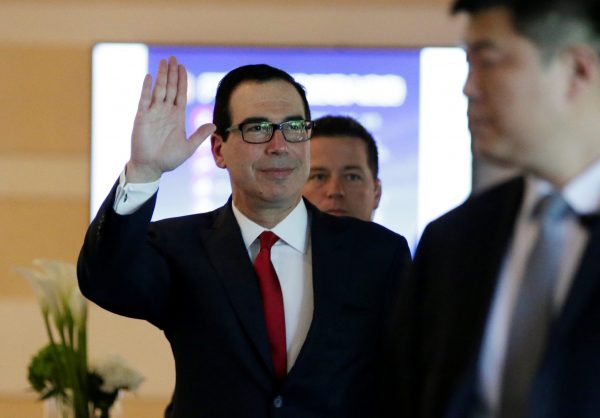According to the report, China ran a modest current account surplus of 0.5 per cent of GDP in the four quarters through June 2018. This was less than the 3 per cent required to find that the surplus was significant. The report also found that the People’s Bank of China’s net intervention in currency markets was by-and-large neutral, despite a 7 per cent weakening of the renminbi since the United States’ imposition of Section 301 tariffs in July 2018. Since this was less than the required 2 per cent of GDP, Beijing was not deemed to have engaged in persistent one-sided intervention.
China’s US$390 billion bilateral trade surplus over the past four quarters did vastly exceed the US$20 billion threshold though. This was judged to be significant.
Given that China satisfied just one of three criteria, it was not branded a currency manipulator. It should not have even been placed on the report’s ‘Monitoring List’ with Japan, South Korea, India, Germany and Switzerland. But consistent with previous reports issued by the Trump administration, China was placed on this list because of its ‘disproportionate share of the overall US trade deficit’.
Four reporting cycles and 650 days into his presidency, Donald Trump has yet to name China a currency manipulator — a label he had promised to tag the country with on his first day in the White House.
US Secretary Steve Mnuchin’s Treasury Department deserves credit for its objectivity and moderation on the China currency issue. The assessment factors that guide the criteria to determine currency manipulation (US$20 billion bilateral trade surplus, 3 per cent of GDP current account surplus and net purchases of foreign currency in excess of 2 per cent of GDP) were devised by former president Barack Obama’s senior Treasury officials. Given the ‘anything but Obama’ fixation of the current Oval Office occupant, Mnuchin could easily have fiddled with these factors to conveniently find and label China a currency manipulator.
Worse, Mnuchin could have borrowed the stained playbook of US Trade Representative Robert Lighthizer and, without confirming any breach of the United States’ currency-related rights by Beijing, recommended that countervailing duties be imposed to offset the margin of ‘subsidy’ conferred on China’s exports due to the renminbi’s depreciation.
Such duties would violate the World Trade Organization (WTO) Agreement on Subsidies and Countervailing Measures. A currency’s value cannot be treated as a prohibited and therefore countervailable export subsidy. Fidelity to international rules is not known to be one of the Trump administration’s stronger points though. Rank violation of the WTO’s two foremost treaty articles did not deter Lighthizer from recommending (and Trump from imposing) the Section 301 tariffs, which now ensnare more than a quarter-trillion dollars of bilateral trade.
In August 2018, China’s ambassador to the United States Cui Tiankai categorically ruled out the possibility of China being made to swallow a second Plaza Accord, akin to the one foisted on Japan in the mid-1980s. The Plaza Accord of September 1985 saw the yen skyrocket in value from 242 yen to the dollar to 120 yen to the dollar by the late-1980s — going on to reach as high as 81 yen to the dollar in April 1995. Appreciation did nothing to correct the large US–Japan trade imbalance, but did assist in inflicting stagnation and deflation on the Japanese economy. The threat to fuel yen appreciation also became a handy implement in the toolkit of US trade negotiators as they bid to force unpalatable market opening demands on Tokyo.
The People’s Bank of China has undoubtedly internalised the searing lessons learnt by the Bank of Japan in placing international currency coordination (for trade rebalancing purposes) above domestic monetary and financial stability considerations. The United States should not hope for a second Plaza Accord to remedy its trade imbalance with China.
It is encouraging in this regard to note that, in an administration otherwise frozen in its view of Asian practices from the 1980s and which seems determined to resurrect the anachronistic trade enforcement toolkit of that day, currency policy will not be a part of that reversion — at least for the next six months. With Trump having launched a multi-front trade war since April 2018, there could have been no better time to overlook the evidence and label China a currency manipulator as a pretext to slap additional duties on imports from China.
Credit that this has not come to pass is due to Mnuchin and his senior team at Treasury. Whether Trump and Chinese President Xi Jinping can begin to lay an emerging pathway out of their mutually destructive trade and technology policy quarrel during these next six months remains to be seen.
Sourabh Gupta is Senior Fellow at the Institute for China–America Studies in Washington DC.
An earlier version of this article was first published here at China–US Focus.

